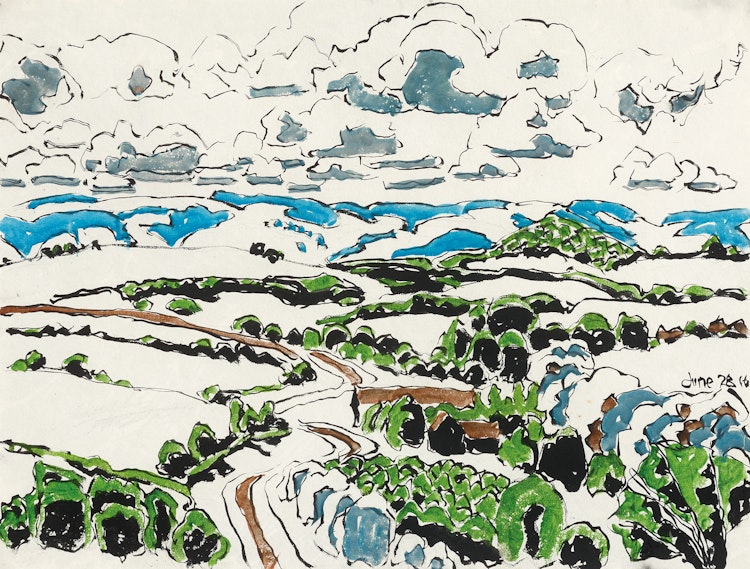Road to Copake, 1916 by David Brown Milne

David Milne
Road to Copake, 1916
gouache and graphite on paper
dated “June 28 1916” at the right edge; an unfinished landscape on the reverse ("Flowing Waterfall, catalogue raisonné no. 107.23); catalogue raisonné no. 107.31
15.25 x 20.25 in ( 38.7 x 51.4 cm ) ( sheet )
Auction Estimate: $40,000.00 - $60,000.00
Price Realized $78,000.00
Sale date: November 27th 2024
Estate of Douglas M. Duncan, Toronto
Acquired by the Winnipeg Art Gallery, 1968
"Paintings by David Milne", Monarch Life Assurance Building, Winnipeg, 1962
"David Milne, Watercolours", Winnipeg Art Gallery, 3 October 1974- 6 February 1975
"Works of Lionel LeMoine FitzGerald and David Brown Milne", Southern Alberta Art Gallery, Lethbridge, Alberta, 4-26 June 1977
"David Milne", Mendel Art Gallery, Saskatoon, Saskatchewan, 2 June-6 July 1980, no. 11
"David Milne (1882-1953)", National Exhibition Centre, Swift Current, Saskatchewan, 18 June-18 July 1981
"Historical Canadian Works from the Collection", Winnipeg Art Gallery, 31 May-19 October 1986
"David Milne", Winnipeg Art Gallery (Exhibition Services); travelling to the Art Gallery of Southwestern Manitoba, Brandon; Thunder Bay Art Gallery, 8 January 1998-28 May 2000
"Selected Works from the Winnipeg Art Gallery Collection", Winnipeg, 1971, reproduced page 129
David P. Silcox, "Painting Place: The Life and Work of David B. Milne", Toronto, 1996, pages 70, 78
David Milne Jr. and David P. Silcox, "David B. Milne: Catalogue Raisonné of the Paintings, Volume 1: 1882-1928", Toronto, 1998, listed and reproduced page 168, no. 107.31
Freshly supplied with new scenic territory to explore, and with time and energy for painting, Milne re-committed himself to his artistic mission. Art historian Katharine Lochnan wrote, “For the next year and a half, he found all his watercolour subjects within a few miles of his house. They were painted on the spot, usually with graphite underpinnings, occasionally even more directly, and Milne claimed not to alter them once they were done. Since, as he said, he was the only audience intended for these pictures, rather than revising when something proved unsatisfactory, he would set the work aside and start again. He painted many pictures of the same subjects; they are both variations on a theme and an obsessive search for what he considered perfection.”
“Road to Copake” features flowing, energetic line work and the clever interplay of painted shapes and negative space. The road winds northwest from Boston Corners through hilly terrain to the close by village of Copake. Milne experimented with a limited palette, comprising of only green, grey, blue and brown. David Silcox observed, “In New York he had invented a vocabulary and a grammar; in Boston Corners he articulated them to the service of more profound thought and more deeply held conviction for the world he saw and painted.”
Share this item with your friends
David Brown Milne
(1882 - 1953) Canadian Group of Painters
Milne was born near Paisley, Ontario. A childhood interest in art, which revived while he was teaching, led him to take a correspondence course and eventually he travelled to New York City to continue his studies. This was somewhat of an exception in the early twentieth-century Canadian art scene as the majority of artists went to Europe to study. While in New York City, Milne worked as a commercial illustrator for several years before deciding to give up this work and devote his time to painting. Shortly after making this decision he moved to Boston Corners in New York.
Throughout his life Milne sought the peace and solitude of a rural life. In his paintings, Milne explored different viewpoints. He greatly admired the work of Tom Thomson but had little interest in the nationalistic approach of the Group of Seven. His themes range from landscapes to views of towns and cities, still lifes and imaginary subjects. His experiments with different media and changing viewpoints show his interest in the process of painting itself. In 1929, Milne returned to settle permanently in Canada, stopping for brief periods in Temagami, Weston, and Palgrave. He built a secluded cabin at Six Mile Lake, north of Orillia, and spent the next six years painting, for the most part, alone. Milne was interested in 'pure' painting, in "adventures in shape, colour, texture and space" as he called his watercolours of the 1930s and 1940s. The change from the less vibrant drybrush "adventures" to the fantasy watercolours is often attributed to the birth of his only child, David Jr., born to Milne's second wife when Milne was sixty. His young son encouraged him to adopt a new, vibrant and often whimsical approach to his art. Milne spent the rest of his life in Uxbridge, north of Toronto, exploring the Haliburton and Bancroft areas as well as the city of Toronto.

